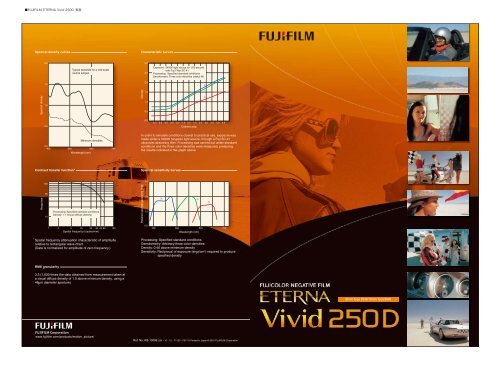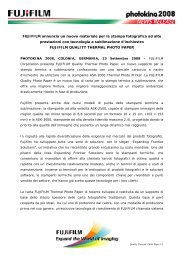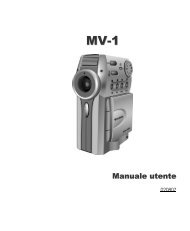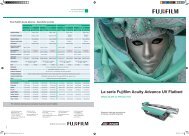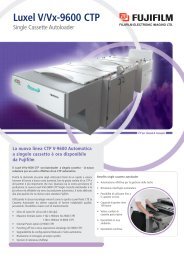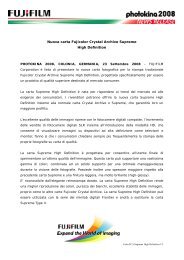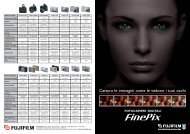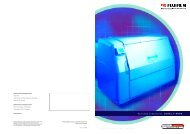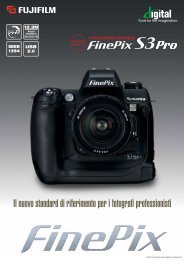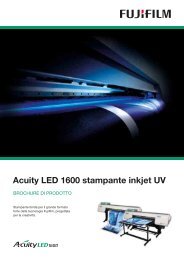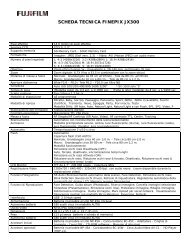FUJIFILM_ETERNA Vivid 250D_è¡¨é¢ * Spatial frequency ...
FUJIFILM_ETERNA Vivid 250D_è¡¨é¢ * Spatial frequency ...
FUJIFILM_ETERNA Vivid 250D_è¡¨é¢ * Spatial frequency ...
Create successful ePaper yourself
Turn your PDF publications into a flip-book with our unique Google optimized e-Paper software.
Spectral density curvesCharacteristic curves2.03.0Typical densities for a mid-scaleneutral subject2.5Exposure: 5400K light source for 1/50 secondwith Fuji Filter SC-41Processing: Specified standard conditionsDensitometry: Three color densities (status M)1.52.0Spectral density1.0Density1.51.00.50.50.0-6.0 -5.0 -4.0 -3.0 -2.0 -1.0 0.0 1.0 2.0 3.0 4.0 5.0 6.0Camera stopMinimum densities0.0400 500 600 700Wavelength (nm)In order to simulate conditions closest to practical use, exposure wasmade under a 5400K tungsten light source, through a Fuji SC-41ultraviolet absorbing filter. Processing was carried out under standardconditions and the three color densities were measured, producingthe results indicated in the graph above.Contrast transfer function*Spectral sensitivity curvesResponse1005010Processing: Specified standard conditionsDensity: 1.1 (Visual diffuse density)1 2 5 10 20 30 40 50 100<strong>Spatial</strong> <strong>frequency</strong> (cycles/mm)Relative spectral sensitivity (log)3.02.01.00.0400 500 600 700Wavelength (nm)* <strong>Spatial</strong> <strong>frequency</strong> attenuation characteristic of amplituderelative to rectangular wave chart.(Data is normalized for amplitude of zero <strong>frequency</strong>.)Processing: Specified standard conditionsDensitometry: Arbitrary three color densitiesDensity: 0.40 above minimum densitySensitivity: Reciprocal of exposure (ergs/cm 2 ) required to producespecified densityRMS granularity3.5 (1,000 times the data obtained from measurement taken ata visual diffuse density of 1.0 above minimum density, using a48 m diameter aperture)35mm Type 8546/ 16mm Type 8646www.fujifilm.com/products/motion_picture/Ref. No. KB-1009E (SK1012F1120F9711) Printed in Japan © 2010 <strong>FUJIFILM</strong> Corporation
Performance Features of <strong>ETERNA</strong> <strong>Vivid</strong> <strong>250D</strong> High color saturationAn evolved version of <strong>ETERNA</strong> series’ Super EfficientDIR-Coupler Technology promotes adhesion and separation ofcolors, creating a rich, translucent palette.Optimized gradation balance<strong>ETERNA</strong> <strong>Vivid</strong> <strong>250D</strong> produces balanced, attractive skin tonesand grays across a wide range of exposure conditions.High contrastThe highest contrast in the <strong>ETERNA</strong> series of motion picture colornegative films combines with a highly saturated palette to producerich, vivid color and crisp, deep blacks.A Seamless Match with <strong>Vivid</strong> 500Sharing the intense, translucent palette of <strong>Vivid</strong> 500,<strong>ETERNA</strong> <strong>Vivid</strong> <strong>250D</strong> makes it possible to create seamless footageduring editing.Enhanced telecine characteristicsExcellent linear response and color balance facilitate color adjustment during telecinetransfer. Optimized orange mask density and sharpness balance result inimproved scanning characteristics. In addition to exceptional sharpness,these improvements also minimize noise during film scanning.<strong>ETERNA</strong> <strong>Vivid</strong> <strong>250D</strong>, your film of choice for sharp images andvibrant colors in open sets, outdoor locations or under mixed lighting.35mm Type 8546/ 16mm Type 8646Introducing <strong>ETERNA</strong> <strong>Vivid</strong> <strong>250D</strong>, high-performance motion picture film delivering clear, crisp images in a rich, vivid pallet,with the depth and dimension of true black. An excellent match with high-speed <strong>Vivid</strong> 500, new <strong>Vivid</strong> <strong>250D</strong> performsimpressively in a variety of shooting scenarios, ensuring optimum results for digital processing of motion picture footage ortelecine transfer for TV commercial films. Break new ground in the expressive range of cinema with <strong>ETERNA</strong> <strong>Vivid</strong> <strong>250D</strong>. Three Technologies Achieve Dramatic Image Quality Super Nano-structured Grain TechnologyFujifilm has developed a technology that precisely controls the light-sensitivestructure of the silver-halide grain to nanoscale, resulting in extremely finegrain. Photons generated by exposure to light are concentrated in thephotosensitive nucleus via electron accumulators. The grain is designed witha precise electron accumulator structure that efficiently concentratesphotons to form the latent image. The grain configuration is preciselyengineered to a thickness that minimizes reflections, effectively limiting lightscatter and boosting sharpness.Super-Efficient DIR-Coupler TechnologyExisting DIR Couplers, which control the image formation process by releasingdevelopment inhibitors during development, produce improved definition andcolor reproduction. Now, a DIR coupler has been developed to workeffectively with the Super Nano-structured Grain, resulting in furtherenhancements in color and sharpness.Super-Efficient Coupler TechnologyA yellow coupler has been developed for enhanced color formation effectduring processing. This highly efficient color formation makes it possible tocreate a thinner layer of emulsion, minimizing dispersion of light andcreating crisp, clear images with little distortion. Exposure indexDaylight . . . . 250Tungsten light (3200K). . . 64 (with Kodak Daylight Filter No.80A)Numbers are for use with exposure meters marked for ISO/ASA speeds. Please note,however, that recommended exposure indexes may not apply due to differences inexposure meters, how they are used, and processing conditions. For best results, testexposures should be made based on instructions for the exposure meter to be used. Color balance<strong>ETERNA</strong> <strong>Vivid</strong> <strong>250D</strong> is color balanced for daylight, and requires no filters for use in theseconditions. When shooting under other light sources, the following conversion filters andexposure adjustments should be made.Light sourceDaylight (sunlight + skylight)Tungsten light (3200K)Metal halide lamps (e.g. HMI)Ordinary fluorescent lamps(White light type)(Daylight type)Three-band fluorescent lampsWhite daylight type (5000K)These filter recommendations will provide approximate color temperature conversion. Final color correction should bedone when printing. Reciprocity characteristics<strong>ETERNA</strong> <strong>Vivid</strong> <strong>250D</strong> requires no filter corrections or exposure adjustments for shutterspeeds of 1/1000 to 1/10 second. For exposures of 1 second, open the lens 1/3 of a stop. Film baseFilm is coated on a triacetate safety base. The film base has been tinted light cyan,to prevent fogging of ends that can occur when loading spools of film into thecamera in light. SafelightThis film should be handled in total darkness. Processing<strong>ETERNA</strong> <strong>Vivid</strong> <strong>250D</strong> can be processed with Process ECN-2 and formulas published byEastman Kodak for Eastman Color Negative Film. In the bleaching step, persulfatebleach, ferricyanide bleach or PDTA-ferric bleach (UL bleach) can be used.FilterNoneKodak Daylight Filter No.80ANoneNoneNoneNoneExposure index25064250250250250 Edge markingsThe MR code system [edge number, film identification mark (FN46), and machine-readable barcode for each, film name (FUJI V250), emulsion number, roll number, frame marks(4 perforations apart for 35mm film; no frame marks for 16mm film)] is printed as latent images. Packaging units and perforationsFilm Width35mm16mmFilm Length and Winding Type30.5m*61m*122m305m30.5m (Single-perforated,type B winding)30.5m (Double-perforated)61m (Single-perforated,type B winding)*61m (Double-perforated)*122m (Double-perforated)122m (Single-perforated,type B winding)122m (Double-perforated)Core/SpoolItems marked with an asterisk are available on a special order basisShape, Pitch, and Specificationof Perforations30.5m spool35 x 50mm core N-4.740mm(Negative perforations with short pitch)35 x 50mm core [ISO 491:1988]35 x 30mm core30.5m spool30.5m spool61m spool61m spool122m spool16 x 50mm core16 x 50mm spool1R-7.605mm(Single perforations with short pitch)2R-7.605mm(Double perforations with short pitch)[ISO 69:1972] Handling of exposed filmExposed film should be processed as soon as possible. If exposed film cannot beprocessed within one week of exposure, it should be stored at temperatures below10°C (50°F) and processed as soon as possible.


